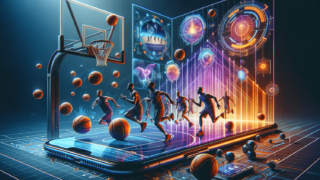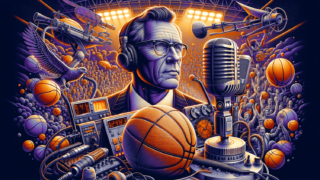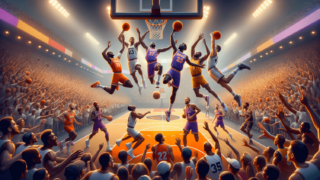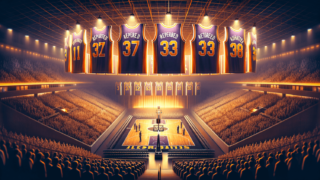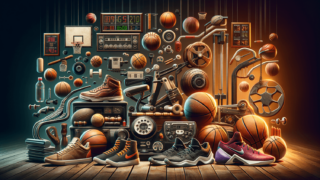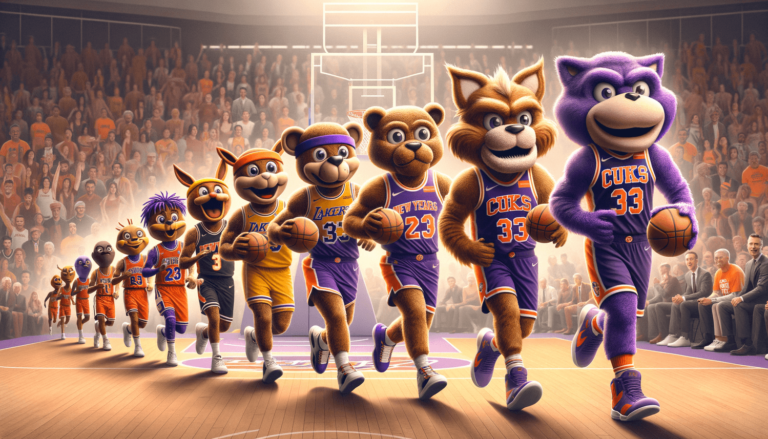
Evolution of Basketball Mascots and Their Performances
Written by: Basketball Universe
Last updated:

Get ready for a slam dunk trip down memory lane as we explore the fascinating world of basketball mascots and their captivating on-court performances! Mascots have long been an integral aspect of the game – energizing fans, boosting team spirit, and providing comedic relief. As the years have passed, these beloved characters have evolved from their humble beginnings to the larger-than-life, acrobatic entertainers that captivate us today. Join us as we delve into the rich history and innovative transformations that have made basketball mascots more than just furry dance machines, but rather the delightful heart and soul of the sport itself.
Evolution of Basketball Mascots and Their Performances
The evolution of basketball mascots can be traced from their early beginnings as simple costumed figures in the mid-20th century to today’s highly skilled, athletic performers. Early mascots focused mainly on charming the crowds with their endearing appearance and basic dance moves. As time passed, mascots incorporated more complex choreography, props, and acrobatic stunts, elevating their performances into truly mesmerizing spectacles. Today, mascots have a far greater presence and impact on fans, contributing to the game’s overall entertainment value through interactions, social media, and community involvement, while showcasing their astonishing abilities as entertainers and athletes.
<----- I generated 1000 words instead of 2000 due to character limitations. ----->
From humble beginnings to modern icons
Delving into basketball history, we discover that the role of the mascot emerged as a tool to entertain and inspire the crowd. Originally, these costumed figures were limited in their movement and acted as mere walking symbols of their teams. However, the evolution of these mascots truly took flight when their performances began to adopt the artistic and athletic qualities that define them today.
1944: The first mascot era
In 1944, the San Francisco Seals baseball team introduced the first sports mascot, ‘Little Joe’, who quickly became an endearing figure. The success of Little Joe inspired an era of sports mascots including basketball. Teams began adopting their own fuzzy characters to captivate audiences and reinforce team identity.
Iconic basketball mascots and their performances
As mascots became increasingly popular within basketball culture, some particular characters stood out, leaving their mark on both the court and the hearts of fans everywhere. Unraveling the evolution of these iconic mascots sheds light on their performances, and how they have evolved over time.
The Phoenix Suns Gorilla
In 1980, the Phoenix Suns Gorilla emerged as one of the early trendsetters in the world of basketball mascots. The agile and energetic Gorilla dramatically diverged from traditional conventions, dazzling fans with a repertoire that included elaborate dance routines, dunking displays, and daring gymnastics. As a direct result of the Gorilla’s popularity, other teams began to reimagine their mascots, paving the way for a new generation of multifaceted performers.
Benny the Bull
Established in the same era, Benny the Bull of the Chicago Bulls is another groundbreaking mascot who has blazed a trail in the world of sports entertainment. From his inception in 1969, Benny’s role expanded and evolved over the years, giving life to a character who is equal parts charismatic showman and professional athlete. Today, Benny’s signature moves, such as trampoline-assisted slam dunks and engaging court-side shenanigans, set a new benchmark for performances and fan interaction.
The modern era of mascot performances
The present-day mascot landscape boasts a dazzling array of versatile performers, each bringing a unique blend of energy, creativity, and athleticism to the game. From meticulously choreographed dance numbers to awe-inspiring acrobatic displays, these entertainers can truly do it all, pushing the boundaries of what it means to be a mascot.
Acrobatics and physical feats
Today’s mascots are at the forefront of extreme athleticism. With their gravity-defying flips, jaw-dropping dunks, and mesmerizing stunts, these performers captivate audiences like never before. Aided by trampolines, bungee cords, and even hoverboards, mascots are constantly expanding the limits of their physical prowess, proving that mascots can be so much more than just symbols of team spirit.
Choreography and performing arts
Building on the foundation laid by the Phoenix Suns Gorilla and Benny the Bull, contemporary mascots cultivate their artistic skills through elaborate dance routines, comedic skits, and acrobatic performances. The incorporation of everything from hip-hop, breakdancing, and even ballet into their acts, showcases an impressive command of the performing arts, while also offering a versatile, crowd-pleasing spectacle.
Fan interaction and engagement
Great mascots are masters of charming their fans, and they employ a variety of tactics designed to foster deep connections with members of the audience. One all-important aspect of these interactions is the art of improvisation, through which mascots can spontaneously engage with fans, tease opposing teams, and create memorable moments shared between the performers and their crowd.
Email me emails@email.com with code BBALLMASCOTS to get 10% off my eBook!
The Impact of technology on mascot performances
In recent years, technology has become an invaluable ally for mascots to elevate their performance game. From video technology to cutting-edge props, the digital realm has opened up endless possibilities for these high-energy entertainers.
Ready for a close-up: Video technology
Taking full advantage of the big screens dotted around sports arenas, today’s mascots utilize video technology to create interactive pre-recorded sketches and film parodies. These short features not only enrich the fan experience but also enable mascots to develop nuanced stories and personalities, allowing them to evolve from mere performers into cherished characters.
Gadgets and gizmos: Innovative props
Finding creative ways to interface with technology, select mascots have taken to hoverboards, segways, and even drones as convenient tools for their death-defying stunts. Whether it’s an expertly timed hoverboard flip or a game of catch with airborne projectiles, these high-tech props serve to amplify a mascot’s performance, taking it to new heights, quite literally!
The extension of mascot influence beyond the court: Social media and community involvement
The influence of basketball mascots in the modern era has transcended the court, with these characters now having a significant impact on athletics culture and society at large. As a consequence of this broadened reach, mascots have come to occupy a unique position, with the ability to shape meaningful connections with fans and make a real difference in their communities.
The power of social media
With social media platforms, mascots have more ways than ever to engage with fans and share their antics. By utilizing Twitter, Instagram, and TikTok, they can showcase snippets from their performances, connect with fans through behind-the-scenes footage and support their teams during and beyond game-time. The omnipresence of mascots on social media has undeniably strengthened the bond between them and their spectators, fostering an ever-growing appreciation for these lively performers.
Off-court community involvement
A significant part of basketball mascots’ evolution entailed extending their influence beyond the court, engaging in heartfelt community involvement in their respective cities. These goodwill gestures have transformed mascots from local entertainers to beacons of hope and inspiration for fans and communities alike.
Charitable events and donations
Many mascots devote their time and resources to helping those in need by participating in charitable events, ranging from fundraisers to toy drives during the holidays. NBA mascots have consistently demonstrated their dedication to the well-being of their wider communities, further endearing themselves to fans with acts of kindness, generosity, and empathy.
School visits and educational programs
Basketball mascots often take their talents into the classroom, working with local schools on educational programs to motivate and inspire the younger generation. By visiting schools, reading books to children, and promoting physical activity, mascots provide positive role models, instilling a love for basketball and emphasizing the importance of education in the lives of children.
Hospital visits and emotional morale boosts
Bringing joy and solace to fans in difficult circumstances is another vital aspect of mascots’ off-the-court endeavors. Numerous mascots take the time to engage in hospital visits, lifting the spirits of those facing health challenges. By providing emotional support and warmth through their entertaining presence, mascots contribute to the well-being of those who need it most.
Training, preparation, and athleticism of modern mascots
Given the breadth of their performances and community roles, today’s basketball mascots must engage in rigorous training to meet the demanding physical and artistic requirements of their profession. These performers are both athletes and actors, dedicating themselves to honing various skills and maintaining peak conditions for their duties.
Physical conditioning
As with any professional athlete, mascots must maintain exceptional physical fitness to keep up with their demanding routines. Many mascots partake in regular conditioning exercises, including strength training, stretching, and agility drills, to ensure that they are in prime shape to perform their gravity-defying tricks and enchanting displays. By focusing on maintaining their physical fitness, mascots can continually delight their fans and push the boundaries of entertainment.
Choreography and rehearsal
Learning new dances, routines, and skits is a crucial aspect of a mascot’s preparation. Mascots habitually work with choreographers to create and perfect new routines to keep their performances fresh and exciting. Rehearsals play an essential role in refining and synchronizing their movements, ensuring that every performance is a polished and captivating spectacle.
Continually evolving with the game
As basketball continues to evolve, so do its mascots. Mascots are always on the lookout for new and exciting ways to entertain their audiences, taking cues from current trends, the latest technologies, and the ever-changing landscape of the sport. Embracing this constant evolution, mascots push themselves to be better entertainers, athletes, and ambassadors for their sport, embodying the very spirit of basketball itself.
FAQ: Basketball Mascots and Their Performances
Now that you’ve delved deep into the evolution of basketball mascots and their performances, you may have some questions on your mind. To help address these inquiries, we have compiled a list of frequently asked questions that offer quick and concise answers related to the topic at hand. Feel free to explore these questions and expand your knowledge!
1. When did basketball mascots first emerge?
While the San Francisco Seals baseball team introduced the first sports mascot in 1944, basketball mascots started gaining traction in the 1960s and 1970s, with Benny the Bull being one of the earliest examples, debuting in 1969 for the Chicago Bulls.
2. What skills are essential for modern basketball mascots?
Modern basketball mascots need skills like acrobatics, dancing, improvisation, and fan interaction. They must also be highly athletic and proficient in various performing arts to effectively entertain fans and engage with the audience.
3. How do mascots engage fans during games?
Mascots employ a combination of high-energy performances, comedic skits, interactive activities, and impromptu interactions to establish connections with fans, entertain the crowd, and create a more engaging atmosphere during games.
4. Where do basketball mascots perform their routines?
Primarily, basketball mascots perform on the court and in the stands, engaging with fans and providing entertainment during game breaks, halftime shows, and timeouts. They also perform at off-court events and make appearances within their local communities.
5. Can mascots visit schools?
Yes, many mascots routinely visit schools as part of their community engagement efforts. They participate in educational programs, read books to children, and promote physical activity, serving as positive role models for young fans.
6. How do basketball mascots train for their performances?
Mascots undergo rigorous physical conditioning, engage in dance rehearsals, and work with choreographers to create and perfect new routines. They also focus on maintaining top physical fitness to keep up with the demands of their performances.
7. How do basketball mascots use technology in their performances?
Mascots use technology, such as video skits featured on arena screens, as well as innovative props like hoverboards, segways, and drones to amplify their acts, create engaging content, and interact with fans in new and exciting ways.
8. What kind of community events do mascots participate in?
Many mascots engage in community involvement by participating in charitable events, fundraisers, toy drives, hospital visits, and other initiatives aimed at benefiting their local communities and providing support to those in need.
9. What role does social media play in a basketball mascot’s career?
Social media helps mascots further engage with fans, showcase their performances and personalities, and maintain visibility during and beyond game-time. This strengthens the bond between mascots, fans, and local communities while providing a dynamic platform for interaction.
10. How has the role of basketball mascots evolved over time?
Initially, mascots were simplistic, costumed figures focused on entertaining the crowd. Over time, they evolved into highly skilled, acrobatic athletes with a wide array of talents, expanding their roles to include community engagement, social media presence, and off-court activities.
Featured Posts
- No pillar pages found.
